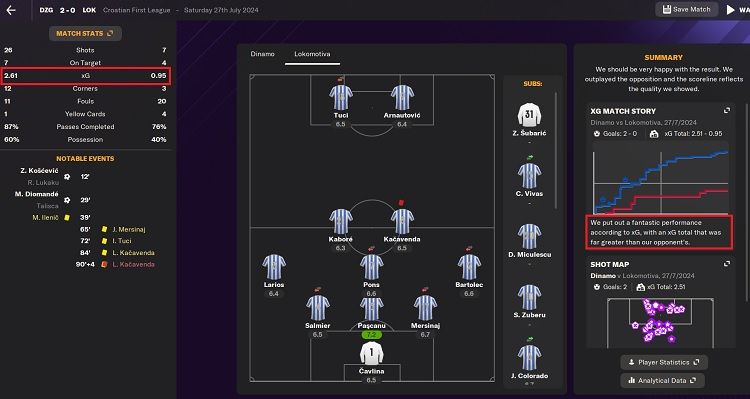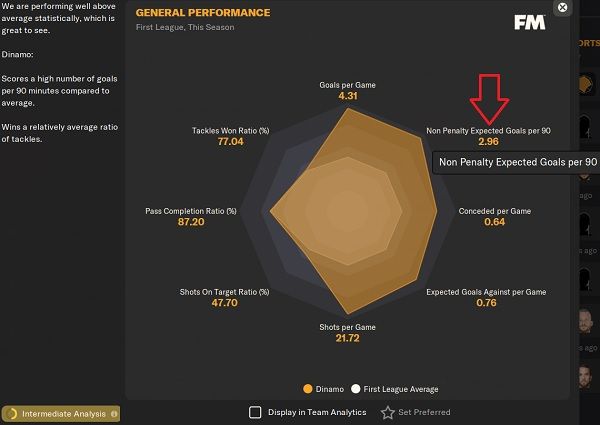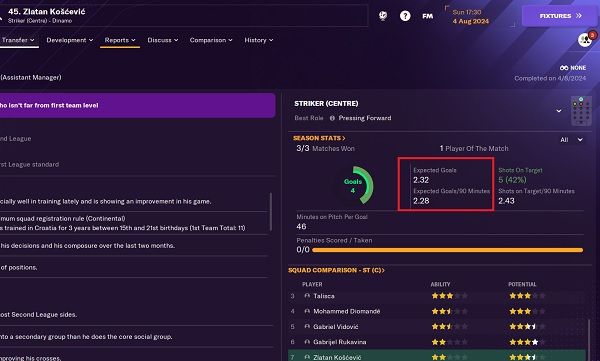Copyright © 2018-2024 nothrow.com. All Rights Reserved. You may not copy and distribute the content from the Site.
Ever heard of XG? XG, short for Expected Goals, is a statistical metric used in football manager games to measure the quality of scoring chances.
It helps us understand the likelihood of a shot resulting in a goal based on various factors such as shot location, angle, and player attributes.
And why is that important?
Research article published in PLoS One in 2023 emphasizes the advanced capabilities of xG models enhanced with new features, demonstrating their superiority over traditional metrics in predicting football outcomes and their wide-ranging impact on football analytics and club management (1).
By analyzing XG, we can make informed decisions about our team’s attacking strategy and player selection. It’s like having a crystal ball that predicts the outcome of our shots.
Who wouldn’t want that?
Key Facts about XG
- ✅ XG, or Expected Goals, offers a nuanced approach to analyzing player performance and team strategies in Football Manager.
- ✅ The metric’s calculation is based on numerous factors, including shot location and angle, providing a more accurate picture of a team’s offensive effectiveness.
- ✅ XG’s integration into Football Manager allows for more informed tactical decisions, player evaluations, and game strategies.
- ✅ While XG has its strengths, it’s important to balance its insights with traditional football metrics for a comprehensive analysis.
- ✅ The future of XG in football analytics is promising, with potential for further refinement and wider application in both virtual and real-world football.
How is XG calculated?

Think of XG, or Expected Goals, as our secret sauce to figuring out how likely our players are to score.
XG is calculated using a complex algorithm that takes into account various factors such as the distance from the goal, the angle of the shot, and the type of shot.
It’s like a football brainiac that considers how far the shot is from the goal, the shooting angle, and what kind of shot it is. It’s like the game’s way of playing Moneyball, assigning a score from 0 to 1 for each shot.
A score of 1 means pack your bags for a goal celebration! This statistical approach allows football managers to assess the quality of their team’s chances and make informed decisions on tactics and player selection.
Why is XG Important in Football Manager?

In the world of Football Manager, XG plays a crucial role in enhancing our decision-making abilities.
By providing us with a statistical measure of a team’s expected goals, XG allows us to assess the effectiveness of our tactics and strategies.
It helps us answer questions like: Are we creating enough scoring opportunities?
Are our players performing at their best? With XG, we can analyze the performance of individual players and make informed decisions about transfers and player development.
It also helps us evaluate the success of our game plans and adjust them accordingly. XG is like a secret weapon that gives us an edge in the game.
Benefits of XG in Football Manager

Improved decision-making
When it comes to making decisions in the football manager game, improved decision-making is crucial.
That’s where XG comes in. By analyzing the expected goals (XG) of different players and teams, we can make more informed choices on who to sign, who to start in a match, and which tactics to employ.
XG provides us with valuable insights into a player’s performance and a team’s attacking prowess. It helps us answer questions like: Which players have a higher chance of scoring?
Which teams are more likely to create scoring opportunities? With XG, we can strategically build a strong team that has a higher chance of success on the virtual pitch.
Enhanced player scouting
When it comes to player scouting, XG provides valuable insights that can greatly benefit us.
By analyzing the expected goals (XG) of players, we can determine their ability to create and convert scoring chances. This information allows us to identify hidden gems and make informed decisions when signing new players.
With XG, we can go beyond traditional scouting methods and uncover players who may not have impressive stats but possess the potential to be game-changers. So, why settle for ordinary when we can use XG to discover extraordinary talent?
Strategic gameplay
When it comes to tactics in the football manager game, XG can be a game-changer. It provides valuable insights into the effectiveness of different tactics and formations.
By analyzing the XG data, we can make informed decisions about how to approach matches and exploit the weaknesses of our opponents. Want to know how well your team performs against strong defensive teams? XG can give you the answer. Looking for the best attacking strategy against a particular opponent?
XG has got you covered. With XG, we can fine-tune our tactics and make sure we are always one step ahead of the competition. So, why rely on guesswork when we can use XG to gain a tactical edge?
Limitations of XG in Football Manager Game
While XG is a valuable tool in the football manager game, it is important to note that it may have some limitations, including inaccuracy in certain situations.
This means that the XG metric may not always accurately predict the outcome of a specific play or match. However, it is essential to consider that XG is just one of many factors to consider when making decisions in the game.
By understanding its limitations and using it creatively, XG can still be a useful tool for evaluating player performance and making strategic decisions. So, how can we navigate the inaccuracy of XG and still make the most of its benefits?
Lack of context
While XG is a valuable tool in the Football Manager, it’s important to acknowledge its limitations.
One of the main drawbacks of XG is the lack of context it provides. XG calculations are based on statistical data and do not take into account the specific circumstances of each match or the individual player’s skills.
This means that XG may not accurately reflect the real-life dynamics of a game. However, it’s crucial to remember that XG is just one piece of the puzzle when it comes to making strategic decisions in the game.
By combining XG with other factors such as player form and tactical considerations, managers can make more informed choices and enhance their overall gameplay experience.
Overreliance on statistics
While statistics can provide valuable insights in the football manager game, it’s important not to rely on them blindly.
We must remember that football is a dynamic and unpredictable sport. Can statistics truly capture the essence of a player’s performance? It’s crucial to consider other factors such as player chemistry, team dynamics, and individual skills.
By balancing statistics with our own observations and intuition, we can make more informed decisions and create a winning strategy. Let’s not forget that football is a beautiful game that goes beyond numbers!
XG is a valuable tool
XG stands out as a valuable tool for making informed decisions. This statistical measurement provides us with a deeper understanding of the game, allowing us to assess the quality of chances created and the likelihood of scoring.
By analyzing XG, we can identify the strengths and weaknesses of our team and opponents, enabling us to devise effective strategies.
But, like any tool, XG has its limitations.
It may not always accurately represent the outcome of certain situations and lacks the context of real-life factors. By considering these limitations and using XG as a supplement to our own observations and instincts, we can enhance our gameplay and make smarter decisions.
Considerations when using XG
When using XG, it’s important to keep a few things in mind. Football Manager is all about making strategic decisions and managing your team to success. XG can be a valuable tool in helping you make informed decisions, but it’s not the only factor to consider.
It’s important to remember that XG is based on statistical calculations and may not always accurately reflect the reality of the game. It’s also crucial to consider the context in which XG is being used.
While it can provide insights into player performance and scouting, it’s essential to supplement it with other information and your own observations. Finally, it’s important not to rely solely on XG and neglect other aspects of the game.
Football Manager is a complex and dynamic simulation, and using XG as a guide rather than a definitive measure can lead to a more enjoyable and realistic experience.
Future developments in XG technology
As we look ahead to the future of XG technology, we can’t help but wonder how it will continue to revolutionize the football.
With advancements in data analytics and machine learning, xG will become even more accurate and reliable. Imagine being able to make strategic decisions based on real-time xG predictions, giving us an edge over our opponents.
Additionally, there is the potential for incorporating xG into player development and training programs, allowing us to optimize our team’s performance. The possibilities are endless, and we can’t wait to see how xG evolves in the coming years.
In Conclusion
In conclusion, understanding and effectively utilizing XG in Football Manager can significantly enhance your gameplay, providing a deeper insight into the game’s intricate tactical and strategic aspects.
By embracing this advanced metric, managers can make more informed decisions, leading to a more successful and rewarding gaming experience.
FAQs
What is XG in Football Manager?
XG, or Expected Goals, is a statistical measure that estimates the likelihood of a shot resulting in a goal, considering factors like shot location, angle, and game context.
How does XG differ from traditional football metrics?
Unlike traditional metrics that focus on outcomes (like goals scored), XG evaluates the quality of scoring opportunities, providing a deeper insight into a team’s offensive effectiveness.
Can XG data influence tactical decisions in Football Manager?
XG data can guide tactical decisions, helping managers optimize formations, player selections, and in-game strategies to create better scoring opportunities.
Is XG applicable for player scouting in Football Manager?
XG can help identify players adept at creating or converting high-quality scoring chances, enhancing your team’s overall performance.
What is the future potential of XG in football analytics?
XG’s potential in football analytics is vast, with possibilities for further refinement and application in player evaluation, match analysis, and tactical planning in both virtual and real-world football.
How does XG calculation consider different shot types?
XG calculation differentiates between shot types (like headers, volleys, etc.), considering their historical likelihood of resulting in goals to assign a probability score.
Can XG data be misleading in certain scenarios?
While insightful, XG data can be misleading if not balanced with other performance metrics and contextual game analysis.
How has XG influenced professional football?
In professional football, XG has influenced team strategies, player scouting, and performance analysis, becoming a crucial tool for many clubs and analysts.
What are some limitations of XG in Football Manager?
XG, while powerful, doesn’t account for every game aspect, like individual player skills or team chemistry, and should be used as part of a broader strategy.
How can I effectively use XG in my Football Manager gameplay?
To effectively use XG, focus on creating high-quality scoring opportunities, analyze player performance through an XG lens, and adapt your tactics to maximize your team’s goal-scoring potential.
Give us feedback: Was his article helpful?

Comments are closed.